Contents
Absinthe, prepared at home, is much better and more drinkable than what world producers offer us. Among other things, this is perhaps the only way to taste the exact drink that Van Gogh, Picasso, Baudelaire or Maupassant enjoyed in their time. After all, you can choose the ingredients with particular captiousness, especially wormwood, so that your absinthe will contain the right amount of thujone and other essential oils, which for a long time does not contain “castrated” absinthe.
There are a great many ways to make absinthe at home, as well as the recipes themselves. But they all come down to the same pattern:
Infusion → Distillation → Coloring → Aging
In each of the recipes, only the first stage differs significantly, and then only in the variety of herbs that can be soaked in alcohol. Otherwise, the technology is equally applicable to each of the recipes below. And I assure you, making homemade absinthe is much easier than it might seem at first glance. The most difficult thing is to get high-quality alcohol and assemble a suitable distiller – the rest is a matter of technique and experience.
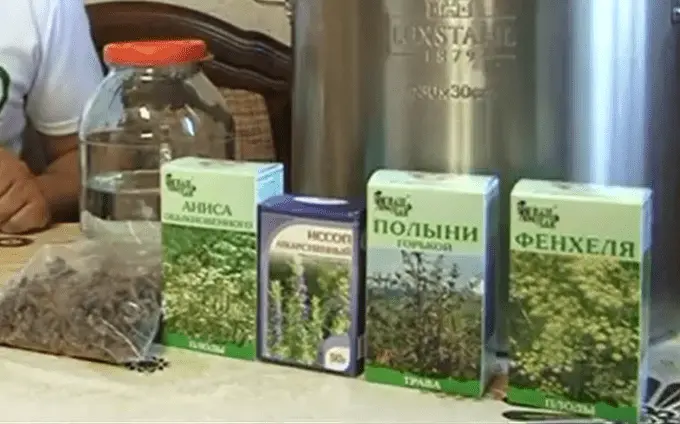
Preparation of herbs for homemade absinthe
So, let’s start with the basics. Absinthe is a strong alcoholic drink based on neutral alcohol and aromatic herbs. Its strength ranges from 50 to 85% alcohol content, and herbal essence from 1 to 3 g/l. At the same time, 10% of the essence should be wormwood and / or Roman. Mandatory for absinthe are wormwood, fennel seeds and anise – the rest only improves the taste and makes it richer. It is also very important to find hyssop – without it, tinting the finished absinthe is possible, but not desirable.
The main rule when preparing herbs for absinthe is to select only leaves and flowers, which means that it is better to collect herbs during their flowering period. The fact is that the stems will act as ballast – they will simply absorb valuable alcohol, which is very problematic to take away, but at the same time they do not contain or contain a negligible amount of essential oils. The roots can be used, but they should be crushed before cooking. The seeds should not be crushed, since in addition to essential oils they also contain fatty oils that pollute the drink.
Most herbs can be purchased at the pharmacy, but they are usually of mediocre quality. My good friend, who has been making absinthe for many years, buys all the herbs on the market, from grandmothers – this is the easiest and most adequate way out of the situation. But if you live near forest plantations and you are not too lazy to go for herbs, then I advise you to do just that.
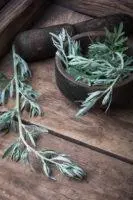
Sagebrush bitter / Artemisia absinthium / Grand Wormwood
It grows almost everywhere, and accumulates essential oils mainly in the tops of the stems, leaves and inflorescences. Especially in the latter, therefore, wormwood should be harvested during its flowering period, namely in late July – early August. Collect inflorescences and upper leaves should be from 10 to 11 am, wearing rubber gloves, as the grass has a very strong, difficult to remove aroma. We cut off 15-25 cm from the top, then dry it and select the inflorescences and leaves with gloves, separating them from the stems. In principle, other herbs can be harvested in the same way.
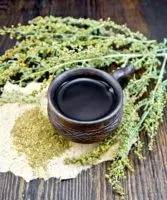
Wormwood Roman, Pontic / Artemisia pontica / Roman wormwood
It mainly grows in the Mediterranean, but is also found in our country as an ornamental garden plant. If, after a long search, you still could not find it, then I recommend experimenting with other similar herbs: tarragon, thyme, yarrow. Roman wormwood is usually used in a mixture with wormwood.

Hyssop / Hyssopus officinalis L. / Hyssop
Small shrub. It can be found in gardening markets, at grandmothers, in pharmacies, but less and less every year. It is somewhat reminiscent in taste and smell of thyme (thyme), which is the best substitute for hyssop.
Anise, of course, refers to the Mediterranean herb. We only need seeds. If star anise is indicated in the recipe, then we are looking for star anise – “Chinese anise”. With fennel and coriander, everything should be clear. Melissa (melissa officinalis) is an obligatory herb for coloring absinthe – we take it in the garden, if not, we replace it with Turkish mint, in extreme cases, peppermint.
The main sources of thujone in absinthe are wormwood and roman. For example, in the usual bitter wormwood (artemisia absinthium) thujone contains 59,9% of the total essential oils.
Traditional Recipes and Herbal Soaking
Let’s move on to the most interesting. This chapter describes recipes for making absinthe, namely sets of herbs for soaking them in alcohol. The soaking process itself is also described, since in some recipes it has its own characteristics and I decided not to do a separate chapter.
The first recipe is based on the books Absinthe Suisse de Pontarlier 1855 and Absinthe Extra-Fine 1891. On the Web it is called absinthe from Pontarlier. He is the simplest. Having mastered it, you can prepare any other absinthe without any problems. Proportions are given for the preparation of 1 liter of drink. If you want to cook more or less, increase or decrease the amount of ingredients proportionally.
Absinthe recipe from Pontarlier (1855, France)
- 25 g of bitter wormwood (artemisia absinthium), can be increased to 100 g;
- 50 g of anise seeds;
- 50 g fennel seeds;
- 950 ml food alcohol 85%.
For tinting:
- 10 g of hyssop;
- 5 g of lemon balm;
- 10 g of Roman wormwood.
To familiarize yourself with the recipe, it is recommended to use 25 g of bitter wormwood, but with 100 g the drink is more interesting. I won’t tell you where to get alcohol – our homeland is immense, but a lot of comments are attached to the article about Limoncello, among which there are also tips on the sources of alcohol in Moscow. In the same place I tell where it can be found in general. If you use pharmacy wormwood, then before soaking it is recommended to sort it out, remove the stems, leaving leaves and flowers, and grind or crush the roots in a mortar.
Soaking: pour herbs and seeds into a jar and pour alcohol diluted to 85% (how to do this is described in this article). We insist in a dark cool place for 2-4 weeks. There is also a quick soaking method, which is called “hot”: we put the jar on an electric heater, a heating radiator, a water bath, etc. for 12-36 hours. The temperature during “hot soaking” should not exceed 30-40 °C. It should also be borne in mind that during rapid soaking, pressure arises in the jar, so it is advisable to equip it with a water seal. In other words, it is better to wait 2 weeks.
Absinthe recipe from Dick’s Encyclopedia of Practical Recipes, 1903
- 15 g bitter wormwood;
- 20 g of Roman wormwood;
- 25 g fennel;
- 25 g star anise;
- 25 g green anise (seeds);
- 4 g of coriander;
- 10 g of hyssop;
- 1 liter of alcohol 95%.
For coloring:
- Xnumx mint;
- 3 g of lemon balm;
- 5 g of Roman wormwood;
- 5 g licorice (licorice root).
Soaking: first moisten the crushed herbs and seeds with a little water and let it soak. Then pour them with 1 liter of alcohol and soak for 3 days in a dark place at room temperature. Then add 0,83 liters of water and let stand for another 1 day. The infusion will be ready for distillation. You should get 1,25 liters of the finished drink with a strength of 60-70%.
Absinthe recipe from Dale Pendell’s Pharmako/Poeia, 1872
- 30 bitter wormwood;
- 8,5 g of hyssop;
- 1,8 g of air;
- 6 g of lemon balm;
- 30 g of anise;
- 25 g fennel;
- 10 eggplants;
- 3,2 g of coriander;
- 0,8 l alcohol 85-95%.
For tinting:
- 4,2 grams of mint;
- 1,1 g of lemon balm;
- 3 g of wormwood Roman / bitter;
- 1 g lemon zest;
- 4,2 g licorice (licorice)
Soaking: Soak all herbs and seeds for a week, shake occasionally. Before distillation, add 0,6 liters of water and soak for another 1 day. You should get about 1 liter of a drink with a strength of 70% in the Swiss style.
Distillation of absinthe
Attention! The distillation of alcohol is a very dangerous process, since alcohol is a flammable liquid. Not recommended for home use. This article should in no way be considered by you as a guide to action. It is written for informational purposes and is purely encyclopedic in nature.
This chapter describes the process of distilling homemade absinthe according to the first recipe. This process is also applicable to the other two, with only one amendment – each of the recipes contains the required amount of water that must be added to the alcohol infusion before distilling it. For the first recipe, this is 450 ml of clean, settled water.
Distiller
I rely in part on your experience and technical equipment. When choosing a distiller, you need to keep in mind that the filling rate of the distillation cube is 2/3 of the total volume, most often it is 4/5. If you do not have a moonshine still, then first ask your friends and acquaintances. But if you are going to prepare other drinks using a distiller, for example, gin or sambuca, I recommend that you assemble a simple and budget option from laboratory glass – all of its components can be bought in online stores or on the market. It will be enough to purchase:
- a glass round-bottom heat-resistant flask for 2 liters minimum;
- downward Liebig refrigerator (or any other glass or metal condenser);
- 2 hoses for connecting the refrigerator to the water supply;
- Wurtz nozzle for connecting the flask and refrigerator;
- lid for the Wurtz nozzle, which can be replaced with a thermometer.
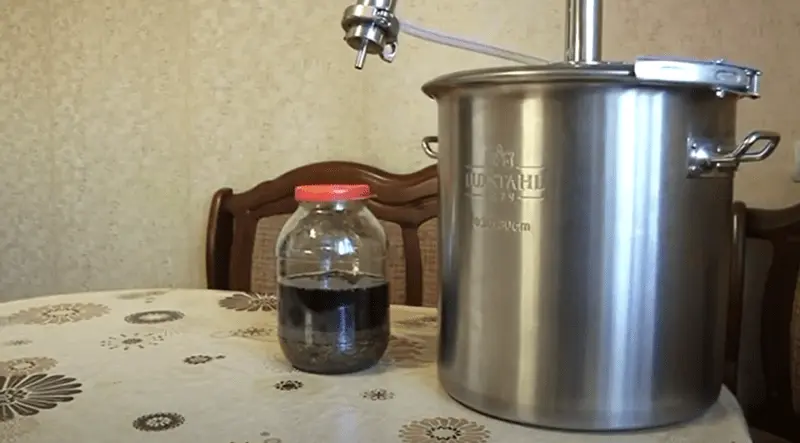
The simplest distiller for homemade absinthe
You can’t put the flask on an open fire, so it’s best to use a sand or water bath to heat it (take a frying pan with high sides and fill it with sand or salt, or take a large pot of water and place the flask in it already). Water to the refrigerator should be supplied from the bottom up. The flask can be replaced with any other distillation cube, for example, a pressure cooker.
Distillation
If you are not familiar with the principles of distilling homemade drinks, I recommend reading this article. Our infusion, diluted with water, is poured into a flask / distillation cube, we collect the distiller and put it on fire. Pour directly with herbs and finish the distillation after one herb remains in the distiller. We heat it over medium heat until the first drops of absinthe begin to drip – these are the heads. We select 3-5% of the total amount of distilled liquid. From the first recipe, it is enough to take 30 ml of heads – pour them out.
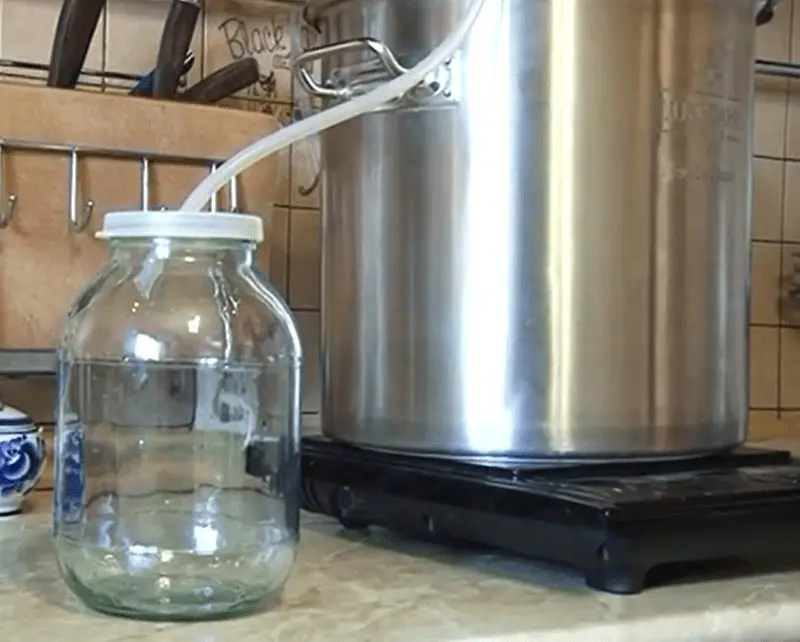
Then we drive on medium-low heat, so that no more than 3-4 drops drip per second. We know that in the end we should get about 950 ml of the finished drink. First, we collect 800-850 grams, after which we change the receiving dishes and collect 50 ml each so as not to miss the tails – they will run more intensively and have a “dirty color”, dregs. There are a lot of essential oils in the tails, so we do not throw them away, but add them to the next batch of absinthe right before distillation. We drive to dryness, but not to the burning of herbs. In a glass flask you can see it perfectly
Coloring and aging
In the end, you should get a certain amount of a colorless liquid with a slight aroma of wormwood and other components (sometimes the liquid has a light straw color). To make a first-class absinthe out of it, you need to tint it, and bring it to an optimal state of taste and aroma. For this, absinthe is insisted on herbs, which are indicated in the recipes.
Tinting occurs as follows: throw the herbs into a jar and fill them with 400 ml of the resulting absinthe (the rest is tightly closed and left aside). We insist absinthe with herbs for a couple of days until it acquires the desired emerald color (or dark green, even dark brown). In the second recipe, the herb should be soaked with ready-made absinthe for 10-15 days, in the third – 3-4 days.
There is also a quick way of coloring – in a water bath. But it is quite dangerous and there are cases when the container burst and the absinthe caught fire. It is better to be patient and tint the drink in a “natural” way.
The tinted half of absinthe must be filtered through 4 layers of gauze, the herbs are squeezed well and the resulting liquid is mixed with the rest. Bring the total amount of the drink to 1 liter (for the first recipe) or using an alcohol meter to 70-72% (or another strength, depending on personal preference).
Get an alcohol meter and preferably electronic scales so that during the preparation of absinthe you operate with exact values and the drink is a success.
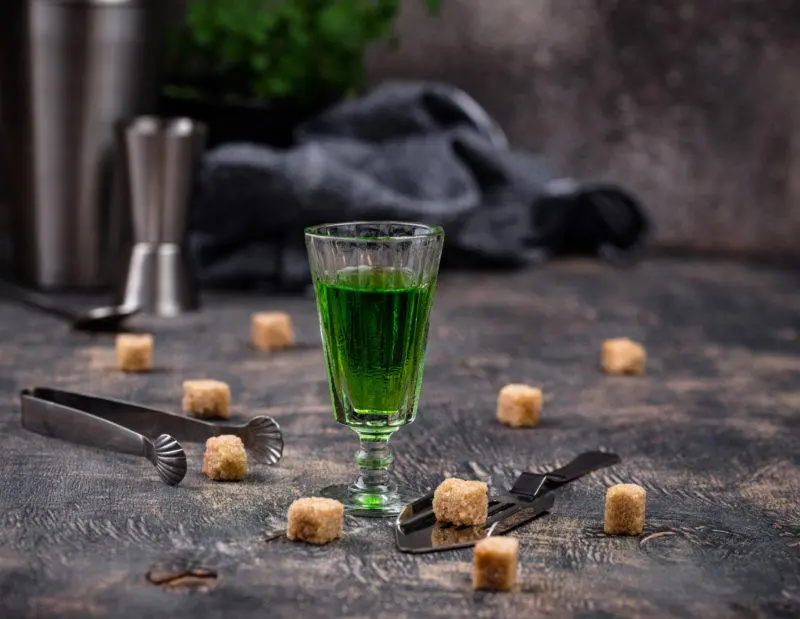
Aging absinthe here refers to its aging. After tinting, the drink has a harsh taste and smell – over time it becomes softer. During storage, the chlorophyll, due to which our absinthe turned green, breaks down and the drink acquires a pleasant yellow hue – you will see this only with home-made absinthe. Commercial analogues contain dyes, so the drink does not lose its bright emerald color. So the yellowing of the drink is good. You can slow down the breakdown of chlorophyll by storing the drink in a dark container, for example, in dark wine bottles.
As an experiment, homemade absinthe can also be tinted red. If my memory serves me, this is done with pomegranate extract. How to drink absinthe we have already described in this article. It presents all the popular ways to use the “green fairy”.
I’m ahead of your questions. Yes, absinthe can be made without distillation, but it will be an ordinary herbal tincture. Yes, I will write prescriptions. No, I don’t know when. And yes, take care of your ears, Van Gogh knows… 🙂









